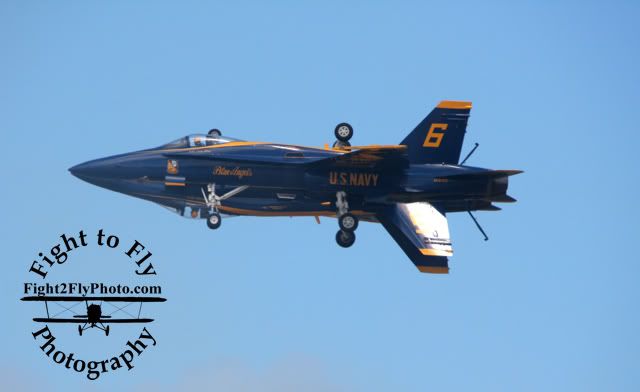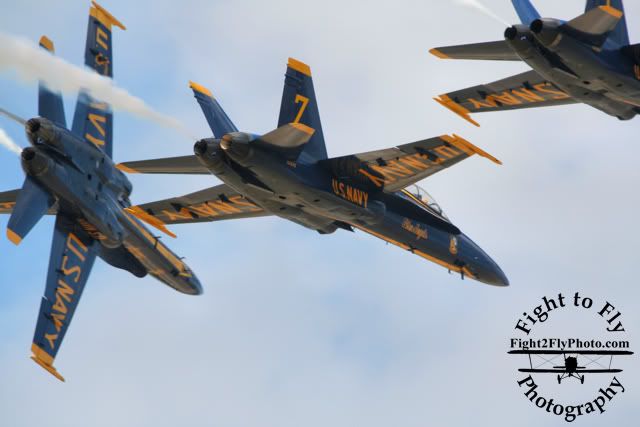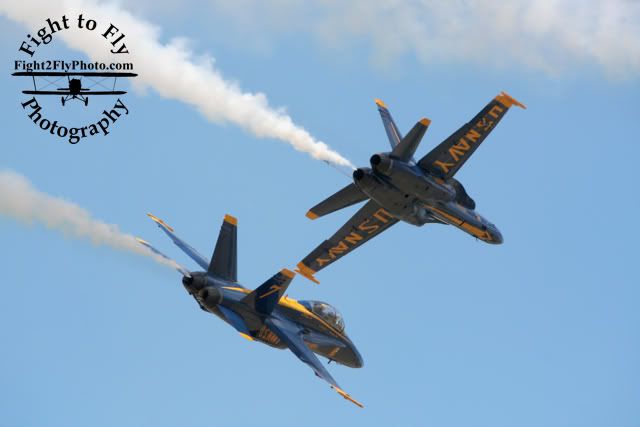
Well, today I had my second flight! And boy was it fun! We reviewed the maneuvers we did on the first flight (loop, spins, aileron roll, and inverted flight) then added a few more: Slow Roll, 2-pt roll, Immelman, and Inside/Outside Humpty-Bump.
The slow roll really has a deceiving name. Speed has nothing to do with the maneuver as it still requires full stick deflection and maximum roll rate. The aileron roll actually traces a corkscrew through the sky, where the slow roll is supposed to be axial. This means the airplane is supposed to maintain constant altitude and heading throughout the maneuver, rotating only along a single axis (longitudinal). The challenge is that it requires precise coordination between all flight controls. Throughout the maneuver your feet are moving constantly to adjust to the rapidly changing roll attitude, and the stick adjusts to keep the nose on the horizon while inverted. It is somewhat disorienting at first as your body gets slammed to the left, then straight up out of the seat, then right, then you settle back down in your seat at the end. (for a roll to the left, of course) It can leave you a little confused at the end. Well, I should say that I could see how that would be possible. It didn't confuse me but I'm a roller coaster junkie and I can't get thrown around enough!
Execution: Start this maneuver at the same speed as the aileron roll, 120 mph. Then simply apply full aileron deflection in the direction you want to roll (for this example it will be a roll to the left). As you move the stick you actually want a little bit of left rudder, but as soon as you've reached the stop start feeding in right rudder. As your wings approach the 90 degree point you'll be feeding in gradually more "top" rudder to maintain attitude and altitude. But beware, too much right rudder and your roll rate will quickly decrease! It is quite noticeable as it is almost as if someone put the brakes on your roll rate. Due to adverse yaw you will find you don't need very much right rudder... much less than the later portion of the maneuver. At the 90 degree bank point you should reach maximum rudder required for the roll then begin to gradually release this pressure on the right pedal as you continue on to inverted. As you pass 90 degrees of bank now you need to start feeding in forward stick. You really need a lot of forward stick for this maneuver, much more than what you may think you need. As you pass the 180 degree mark you'll want to make sure to keep in a good bit of forward stick to help maintain altitude for the maneuver and also begin to add in "top" rudder (left now). When you are at the 270 degree point your rudder input should be at its maximum necessary to maintain attitude and altitude and begin to decrease it once beyond 270 degree point. Again, you will need more left rudder in this maneuver than right. If you have difficulties maintaining altitude/attitude on this maneuver it is most likely due to the inverted portion and beyond. It's a good idea to practice 2 pt. rolls and inverted flight to get a solid picture of where the nose needs to be in relation to the horizon. For the Decathlon there is a very significant difference between where the horizon is in the windscreen for upright and inverted flight.
The biggest problem I was having with this maneuver was putting in the correct amount of right rudder (I always had a lead foot on it and the roll rate would decrease) along with too little forward stick for the inverted portions. Another problem some people experience is relaxing the roll rate. It is important that you remember to keep that stick all the way to the left or right depending upon the direction of course.
The Immelman is simply a half-loop followed immediately by a slow roll to upright. It's quite challenging as you end the maneuver upright only slightly above stall speed. The pull up to the top of the loop really slows the plane down a lot. We start this one at 160mph and ends right on the 55mph mark. I've always been curious as to what the difference is between the immelman and just a half loop. The loop and roll portion of the Immelman is designed to be one fluid maneuver. There is to be no horizontal hesitation between finishing the looping portion and initiating the rolling portion. With the half loop you are supposed to have a hesitation in the inverted position before you initiate the 1/2 roll to upright.
Execution: Initiating this maneuver is the same as the loop except with about 10 extra mph on the airspeed at the beginning. You begin with an abrupt pull (around 4 G's) to raise the nose above the horizon. Just like the loop you look out the front until the horizon disappears behind the instrument panel then shift your scan to the left wingtip. Keep watching out the left window until you reach approximately 45 degrees nose high inverted. Then you begin to look out the top of the aircraft at the horizon as you simultaneously begin a 1/2 slow roll to upright. You want to start the roll at this point because the airplane is flying extremely slow and it takes a lot of energy to swing the airplane around 180 degrees without sinking out of the top. For this left hand roll you will need nearly full left rudder to keep that nose from dropping below the horizon and you'll also have to work that elevator as well to keep the nose moving in the same plane. Once all is said and done and the wings are level the aircraft will be just on the verge of stall. When I did these the first times (and actually did it correctly I might add) the airspeed indicator was showing 60 mph as soon as the wings were level again. From here it is important that you keep that nose up so you do not descend. It's similar in principle to a chandelle because your pitch attitude will be quite high as you accelerate.
The only problems I had with this were due to the timing of that roll and knowing how much rudder I needed. Here you need to start the roll well before you would think it should be started.
The Humpty-Bump is almost as fun to say as it is to fly! It is a vertical maneuver where you perform a 1/4 loop to vertical, hesitate a few brief moments, then abruptly apply aft stick and ride it around until you perform 1/2 of a loop so the nose is pointed straight down again. Since the airplane was going vertical the speed drops very quickly and the actual rotation part of the maneuver is just on the edge of stall. The top is not really a high-g maneuver... probably just about 3 or so, but it's sure fun to see that horizon come around so fast! The recovery at the end is another significant 1/4 loop pull to level. On this maneuver the judges are not looking for constant radius on the 1/4 loops. But they are looking for constant radius 1/2 loop over the top.
The other version of the humpty has you push the nose over the top instead of pull. During that part you literally get thrown straight up out of your seat and your full weight (and then some) is on the harnesses. I'm finding the difficult part of these negative-g maneuvers is keeping constant stick position and my feet on the pedals. No matter how tight the harness is, your body still moves which translates to the stick moving as well. So this can be a challenge on certain maneuvers.
This maneuver is one that I need to pay special attention to as it may cause "gray-out" and lead to disorientation. During the negative g part of the maneuver your blood pools in your head, then you abruptly pull a high positive -g recovery causing all that blood go back into the lower portion of your body. Once blood starts to leave the brain one of the first symptoms is reduction in vision thus the gray out.
Execution: This maneuver will also require a little extra speed on entry due to the hesitation in the vertical position. We fly this at about 160mph as well. You begin with a significant pull to vertical, perhaps even more aggressive than a regular loop. As you watch out the left window after the horizon is no longer visible out the front, you wait for the wing to become perpendicular to the horizon. Once it does you want to apply aggressive forward stick to stop all pitch movement and make a nice, crisp vertical hesitation. The hesitation is very slight in this aircraft and shouldn't even reach 2 seconds. After you wait that brief moment you want to haul back on the stick to pitch that nose right around to swap ends. The airplane is going to be very slow at this point and you want to make sure not to stall the aircraft. Each time I performed it I could feel significant buffeting on the controls throughout the entire 180 degree pitch. This part happens really fast and once the horizon is visible out the front you want to be sure to aggressively apply forward stick at the 90 degree point as your nose is pointed toward the ground. The other thing you need to be aware of is the fact the nose will actually want to yaw as you pitch over the top. Due to gyroscopic precession the nose will want to swing to the right, which will require a slight bit of left rudder. How much you may ask? However much is necessary. After doing it several times you'll get a feel for it (or so I'm told) Make sure to stop all aircraft movement at this time, hesitate a few brief moments, then recover as you would from the backside of a loop. Again, you don't want to hesitate too long as you will be accelerating extremely quickly. This portion should be right at 0-G's since you're headed straight toward the earth. From the cockpit, however, it will feel as negative. That's because the human body is only used to positive G's.
The outside version of this maneuver is just the same thing only reversed. You really need to pitch that nose forward a lot and feed in some serious forward stick. And since it is pitching the nose down you will want to feed in right rudder.
Want an easy way to remember which way the nose will yaw when pitching up? Think of the word "upright." That means when the nose pitches up, it will want to yaw to the right. And if you remember that, you can surely remember the opposite is true as well. Oh yeah, and that rule only applies to North American airplanes. Ones such as Yak's and Sukhoi's will be opposite since their propellers rotate counter clockwise.
So there you have it, flight number two! And now I have to wait until October 15th when my instructor gets back from a business trip to London.

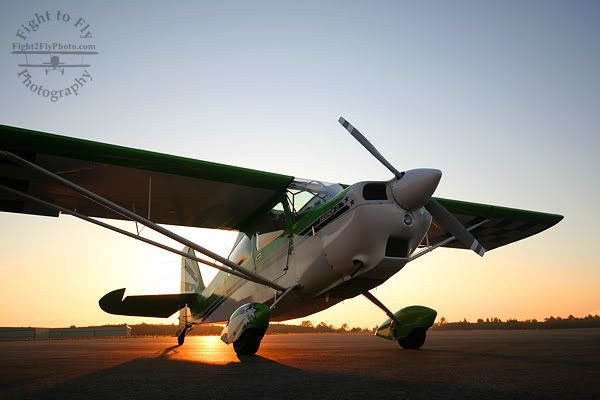
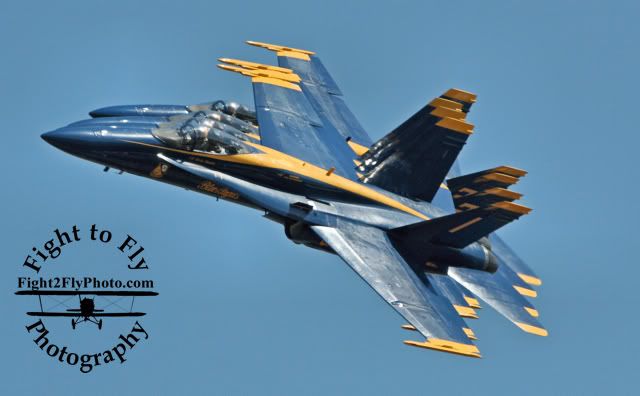 The picture above shows what is a very dynamic maneuver flown by the Blue Angels. Due to the formation and the way it is setup the apperance changes drastically to the observer on the ground.
The picture above shows what is a very dynamic maneuver flown by the Blue Angels. Due to the formation and the way it is setup the apperance changes drastically to the observer on the ground.